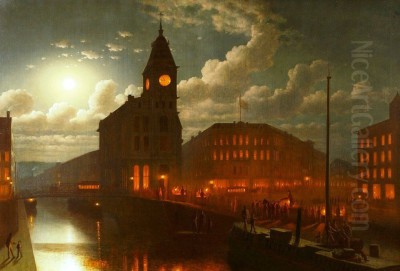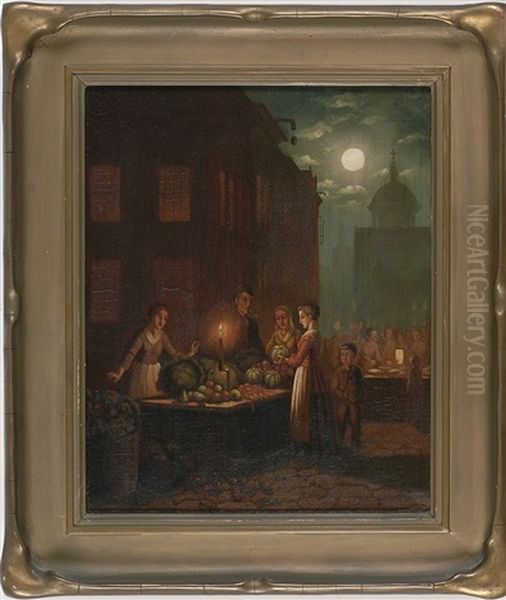
Johann Mengels Culverhouse stands as a fascinating figure in nineteenth-century art, a painter born in the Netherlands who found his audience primarily in the United States. Renowned as a "candlelight painter," his work occupies a unique niche, specializing in nocturnal scenes bathed in the warm glow of artificial light or the cool radiance of the moon. His paintings, often depicting bustling night markets, intimate interiors, or quiet street corners, captured a sense of romantic nostalgia that resonated with viewers on both sides of the Atlantic, bridging European artistic traditions with American sensibilities.
Dutch Roots and Early Life
Born in Rotterdam in 1820, Johann Mengels Culverhouse emerged from a nation steeped in artistic history. Growing up in the Netherlands meant being surrounded by the legacy of the Dutch Golden Age, a period that had produced masters renowned for their depictions of light, domesticity, and everyday life. While specific details about his early training remain somewhat scarce, the environment itself would have been formative. The meticulous realism and atmospheric depth found in the works of seventeenth-century painters were part of the cultural air he breathed.
The Netherlands of the early nineteenth century was still processing the immense artistic achievements of figures like Rembrandt van Rijn, whose dramatic use of chiaroscuro fundamentally changed the way light and shadow were understood in painting. The intimate genre scenes of Johannes Vermeer and Pieter de Hooch, celebrating quiet moments within Dutch homes, also formed a powerful backdrop. This rich heritage undoubtedly shaped Culverhouse's artistic inclinations, particularly his later focus on genre subjects and complex lighting effects. He was one of six children, suggesting a modest family background, but one situated within a city that valued trade, craft, and cultural expression.
Crossing the Atlantic: A New World Canvas

Sometime likely around the mid-nineteenth century, Culverhouse made the significant decision to emigrate to the United States, eventually settling in New York City. This move placed him in a rapidly evolving artistic landscape. America was forging its own cultural identity, and its art scene, while growing, looked often to Europe for inspiration and validation. New York was becoming a major center, attracting artists from various backgrounds and fostering institutions like the National Academy of Design.
For a painter like Culverhouse, America offered new patrons and exhibition opportunities. He began to exhibit his work, finding an audience receptive to his particular style. While he adapted to the American market, his artistic sensibilities remained deeply rooted in his European, specifically Dutch, training and influences. He did not fully assimilate into dominant American styles like the landscape-focused Hudson River School, instead carving out his own distinct path.
The Candlelight Painter: Style and Signature Themes
Culverhouse earned the moniker "candlelight painter" for his exceptional skill in rendering scenes illuminated by artificial light sources – candles, lanterns, and hearth fires. This specialization was not entirely novel; it had distinct precedents in Dutch art, particularly in the work of seventeenth-century artists known as the fijnschilders (fine painters). Masters like Godfried Schalcken were celebrated for their captivating nocturnal scenes, where the limited light source created dramatic contrasts and highlighted textures with jewel-like precision.
Culverhouse embraced this tradition, making it central to his artistic identity. His paintings often feature intricate plays of light and shadow (chiaroscuro), where the warm glow of a candle pushes back the surrounding darkness, creating pockets of intimacy and revealing details selectively. He meticulously rendered the effects of light on different surfaces – the sheen on fabric, the glint on metal, the soft diffusion through smoke or glass. This technical focus was combined with a penchant for genre subjects: people engaged in everyday activities, albeit often set in the evocative context of the night.
His subjects frequently included bustling night markets, a theme he returned to throughout his career. These scenes allowed him to combine his interest in light effects with lively depictions of social interaction. Figures haggle over goods, gather around stalls, or simply move through the illuminated space, creating a sense of community and activity under the cover of darkness. Other common themes involved interiors – taverns, homes, workshops – where candlelight created a cozy or sometimes mysterious atmosphere.
Echoes of the Golden Age
The influence of the seventeenth-century Dutch Golden Age on Culverhouse's work is undeniable and multifaceted. Beyond the specific technique of candlelight painting inherited from artists like Schalcken, the broader tradition of Dutch art provided a deep wellspring of inspiration. The detailed realism and focus on everyday life characteristic of genre painters such as Jan Steen or Gabriel Metsu clearly informed Culverhouse's choice of subject matter and his attention to narrative detail within his scenes.
Furthermore, the Dutch tradition of landscape painting, particularly nocturnal scenes, also finds echoes in his work. Aert van der Neer, a Golden Age master, specialized in moonlit landscapes and winter scenes illuminated by fire, demonstrating an early fascination with capturing the subtleties of light at night. Culverhouse adapted these interests to his own time and settings, often infusing them with a nineteenth-century sense of romanticism and nostalgia that appealed to his contemporary audience. His work represents a continuation and reinterpretation of these established Dutch themes.
Masterpiece in Focus: Moonlit Market
Among Culverhouse's most celebrated works is Moonlit Market, painted in 1874 and now housed in the High Museum of Art in Atlanta. This painting exemplifies many of his signature strengths. The scene depicts a European town square at night, filled with the activity of a market. A luminous moon hangs in the sky, casting a cool, silvery light over the architecture and parts of the square, while warmer, more localized light emanates from lanterns illuminating the market stalls.
The composition skillfully balances these different light sources, creating a complex and atmospheric interplay of light and shadow. Figures are distributed throughout the scene – some browsing goods, others conversing, some gathered around a food stall. Culverhouse captures the gentle hum of activity without making the scene feel chaotic. The background features characteristic European architecture, including a prominent church spire silhouetted against the night sky, adding to the sense of place and perhaps evoking a feeling of nostalgia for viewers familiar with or dreaming of such settings. The painting is a testament to his ability to orchestrate a complex scene, manage intricate lighting, and evoke a specific mood – one of peaceful community gathering under the enchanting veil of night.
Other Notable Works and Themes
While Moonlit Market is a standout piece, Culverhouse produced a considerable body of work exploring similar themes and variations in lighting. Paintings often simply titled Night Market or Market Scene by Candlelight attest to his recurring fascination with this subject. These works allowed him to explore different configurations of figures, stalls, and light sources, showcasing his technical virtuosity in rendering the subtle effects of illumination in darkness.
He also painted numerous interior scenes. Works like Woman Before a Mirror (circa 1850) demonstrate his ability to handle more intimate settings, focusing on a single figure illuminated by candlelight. These interiors often carry a quiet, contemplative mood, contrasting with the livelier energy of his market scenes. Tavern scenes, workshops, or simple domestic interiors provided further canvases for exploring the interplay of light, texture, and human presence within enclosed spaces. Across these varied subjects, the consistent thread remained his masterful control over light and his commitment to a detailed, realistic rendering style rooted in Dutch tradition.
Culverhouse in the Nineteenth-Century Art World
Placing Johann Mengels Culverhouse within the broader context of nineteenth-century art highlights his unique position. In America, the dominant force for much of his active period was the Hudson River School, led by figures like Thomas Cole, Asher B. Durand, and later Frederic Edwin Church. These artists focused on the grandeur and sublime beauty of the American landscape, often rendered in broad daylight with meticulous detail but a vastly different sensibility than Culverhouse's intimate nocturnes.
American genre painting was also developing, with artists like William Sidney Mount, Eastman Johnson, and George Caleb Bingham capturing scenes of everyday American life. While sharing an interest in genre, their styles and subjects – often rural activities, domestic scenes, or political gatherings depicted in clear light – differed significantly from Culverhouse's European-inflected, night-focused canvases.
In Europe, Romanticism still held sway, with artists like Caspar David Friedrich in Germany exploring atmospheric landscapes often imbued with spiritual or emotional significance, including moonlit scenes, but typically on a grander, more symbolic scale. The move towards Realism, championed by artists like Gustave Courbet in France, focused on unidealized depictions of contemporary life, often with a social or political edge distinct from Culverhouse's more nostalgic and picturesque approach. Perhaps his closest contemporary parallel in terms of subject matter and specialization was the Belgian painter Petrus van Schendel, who also gained fame for his meticulously rendered candlelit and moonlit market scenes, suggesting a shared interest and perhaps even a degree of competitive specialization in this niche across Europe and America.
Reception, Popularity, and Critique
Culverhouse's paintings found considerable favor with the American public and collectors during his lifetime. His detailed execution, familiar genre subjects, and particularly his evocative use of light appealed to prevailing tastes. The romantic and often nostalgic atmosphere of his European scenes likely held a certain charm for an American audience still looking towards the Old World for cultural touchstones. His works were exhibited at prominent venues, indicating a degree of professional success and recognition.
However, his adherence to a style deeply rooted in seventeenth-century Dutch art also drew some criticism, or at least positioned him outside the main currents of artistic innovation happening in both Europe and America. Some might have viewed his work as somewhat derivative or repetitive, lacking the bold originality sought by proponents of more modern movements. His commitment to a European aesthetic, even while working for an American market, could be seen as both a strength (offering something distinct) and a limitation (not fully engaging with the developing American artistic identity). Despite this, his skill was generally acknowledged, and his chosen niche proved commercially viable and aesthetically pleasing to many.
Later Years and Enduring Legacy
Information about Johann Mengels Culverhouse's later life is less abundant, but he continued to paint, maintaining his characteristic style and themes. He passed away around 1895. His legacy rests primarily on his popularization and skillful execution of the nocturnal genre scene, particularly the candlelit market. He successfully translated a specific strand of Dutch artistic tradition for a nineteenth-century American audience, creating works admired for their technical proficiency and atmospheric charm.
While perhaps not a major innovator who drastically altered the course of art history, Culverhouse occupies a significant place as a specialist who mastered a challenging technique. His paintings offered viewers a glimpse into evocative, warmly lit worlds, capturing the unique beauty and social dynamics of life after dark. His work serves as a reminder of the diverse artistic currents flowing between Europe and America in the nineteenth century and the enduring appeal of scenes that blend realism with romance, illuminated by the captivating glow of candlelight and moonlight. His paintings continue to be appreciated in museum collections and by private collectors for their distinctive mood and meticulous craftsmanship.
Conclusion: A Master of Nocturnal Atmosphere
Johann Mengels Culverhouse remains a notable figure for his dedication to the art of the nocturne. As the "candlelight painter," he carved out a distinct identity in the nineteenth-century art world, bridging his Dutch heritage with his American career. His meticulous renderings of night markets and intimate interiors, bathed in the dramatic yet subtle interplay of artificial light and shadow, showcase remarkable technical skill. Influenced by the Dutch Golden Age masters yet imbued with a nineteenth-century romantic sensibility, his works captured a specific mood – often nostalgic, sometimes bustling, always atmospheric. While operating somewhat outside the dominant artistic trends of his time, Culverhouse created a body of work that resonated with his audience and continues to hold appeal for its unique focus on the illuminated beauty of the night.